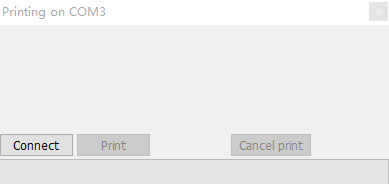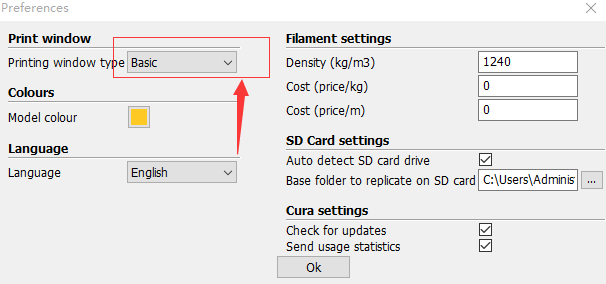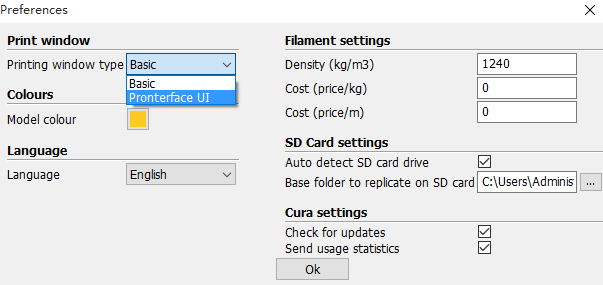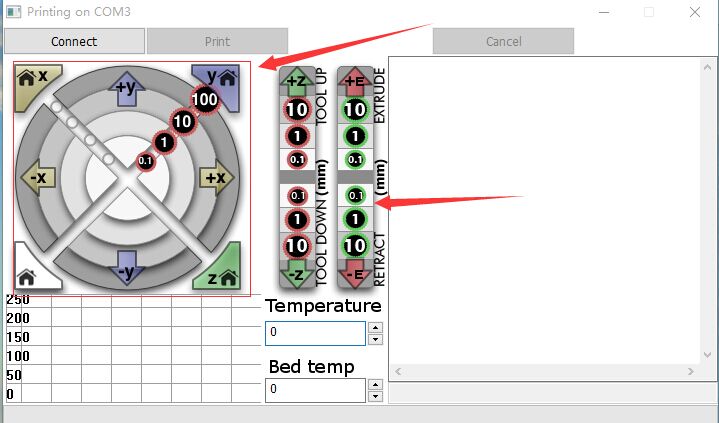Cura 15.04 打印物体,默认是对打印对象进行部分填充,来节省打印耗材,但是打印一些中空的结构的时候,会出现边框强度不够的情况,导致边缘的强度非常差,这时候需要设置完全填充。如下设置即可。注意: 设置后,最好关闭一下软件重新打开,出现过修改无效的情况!
NDK 链接第三方静态库的方法
将NDK编译的第三方静态拷贝到JNI目录下,在Android.mk中添加如下代码
以openssl静态库(libcrypto-static.a)为例
第一种链接方法:LOCAL_LDFLAGS := libcrypto-static.a(不推荐,有编译警告)
第二种链接方法:LOCAL_LDLIBS := libcrypto-static.a(不推荐,有编译警告)
第三种链接方法:(推荐)
|
1 2 3 4 5 6 |
include $(CLEAR_VARS) LOCAL_MODULE := third_static_lib (可以随便起一个名字) LOCAL_SRC_FILES := libcrypto-static.a include $(PREBUILT_STATIC_LIBRARY) //在你要编译的模块中引用third_static_lib LOCAL_STATIC_LIBRARIES := third_static_lib |
Ubuntu自动备份远程服务器上WordPress的脚本
运行命令为:
|
1 |
$ expect backup.sh |
hostback.sh
|
1 2 3 4 5 6 7 8 9 10 11 12 13 14 15 16 17 18 19 20 21 22 23 24 25 26 27 28 29 30 31 32 33 34 35 36 37 38 39 40 41 42 43 44 45 46 47 48 49 50 51 52 53 54 55 |
#!/bin/sh LogFile=~/backup/backup-`date +%Y%m%d`.log #指定日志的名字 BakDir=~/backup #备份文件存放的路径 MD5File=~/backup/md5-`date +%Y%m%d`.txt Sha1File=~/backup/sha1-`date +%Y%m%d`.txt #create backup directory if [ -d $BakDir ] then cd $BakDir touch $LogFile else mkdir -p $BakDir cd $BakDir touch $LogFile fi #backup wordpress datadump=`which mysqldump` wordpressdb="wordpress" #wordpress数据库的名字 wordpresspath=/var/www #wordpress程序文件的位置 mysqluser="root" #数据库的用户名 userpass="password" #用户密码 backupwordpress_tar_gz=$wordpressdb.`date +%Y%m%d`.tar.gz backupwordpress_sql=$wordpressdb.`date +%Y%m%d`.sql if $datadump -u $mysqluser --password=$userpass -h localhost --opt $wordpressdb > $backupwordpress_sql 2>&1 then echo " backup $wordpressdb success" >> $LogFile else echo " backup $wordpressdb error" >> $LogFile exit 1 fi #检验文件尾部是否存在 “-- Dump completed on”,如果存在不存在,则说明备份出错了。 if [ 0 -eq "$(sed '/^$/!h;$!d;g' $backupwordpress_sql | grep -c "Dump completed on")" ]; then echo " backup $wordpressdb error" >> $LogFile exit 1 fi #使用h参数的目的在于把软连接指向的实际内容打包进入,而不是仅仅打包一个软连接 if tar czpfh $backupwordpress_tar_gz $wordpresspath $backupwordpress_sql >/dev/null 2>&1 then echo " backup wordpress success" >> $LogFile rm -f $wordpressdb.`date +%Y%m%d`.sql else echo " backup wordperss error" >> $LogFile exit 1 fi md5sum $backupwordpress_tar_gz >> $MD5File sha1sum $backupwordpress_tar_gz >> $Sha1File |
backup.sh
|
1 2 3 4 5 6 7 8 9 10 11 12 13 14 15 16 17 18 19 20 21 22 23 24 25 26 27 28 29 30 31 32 33 34 35 36 37 38 39 40 41 42 43 44 45 46 47 48 49 50 51 52 53 54 55 56 57 58 59 60 61 62 63 64 65 66 67 68 69 70 71 72 73 74 75 76 77 78 79 80 81 82 83 84 85 86 87 88 89 90 91 92 93 94 95 96 97 98 99 100 101 102 103 104 105 106 107 108 109 110 111 112 113 114 115 116 |
#!/usr/bin/expect -f #开启内部动作调试输出,观察是否正确执行 1 代表打开调试,0代表关闭调试 exp_internal 0 set HostAddr "www.mobibrw.com" set HostPort 22 set UserName "user" set BackupShell "hostback.sh" set Password "password" set BakDir "backup" set timeout -1 #由于通过FTP传输的文件格式可能\n被替换为\r\n 的情况,因此需要执行一下 dos2unix 转化到 \n spawn dos2unix $BackupShell expect eof spawn ssh $HostAddr -p $HostPort -l $UserName rm -rf ~/$BackupShell expect -re ".*assword:" send "$Password\r" expect eof spawn scp $BackupShell $UserName@$HostAddr:~/$BackupShell expect -re ".*assword:" send "$Password\r" expect eof spawn ssh $HostAddr -p $HostPort -l $UserName chmod +x ~/$BackupShell expect -re ".*assword:" send "$Password\r" expect eof #解决在群晖NAS系统上TCP超时问题,增加心跳保持参数 #同时注意,远端语言有可能不是英文,因此需要增加LC_ALL=C强制切换到英文,否则后续匹配可能无法完成 spawn ssh $HostAddr -o TCPKeepAlive=yes -o ServerAliveInterval=30 -p $HostPort -l $UserName "LC_ALL=C sudo -E bash ~/$BackupShell" expect -re ".*assword:" send "$Password\r" expect eof spawn scp -r $UserName@$HostAddr:~/$BakDir ./ expect -re ".*assword:" send "$Password\r" expect eof #backup-20151227.log\nbash: warning: setlocale: LC_ALL: cannot change locale (zh_CN.utf8) 这种情况要注意 proc getFilterFile { host port user bakdir password filter regx} { spawn ssh $host -p $port -l $user ls ~/$bakdir | grep $filter expect -re ".*assword:" send "$password\r" expect -re "$regx" expect eof return [string trimright $expect_out(0,string)] } cd ./$BakDir #校验MD5,SHA1 set MD5File [getFilterFile $HostAddr $HostPort $UserName $BakDir $Password "md5" "md5(.*).txt"] puts stdout $MD5File #修改语言环境,否则md5sum,sha1sum返回的结果中可能不会出现"OK",而是会出现“确定” #“失败” if {[info exists ::env(LANG)]==1} { set ORG_LANG "$env(LANG)" puts stdout "$env(LANG)" set env(LANG) "C" puts stdout "$env(LANG)" } if {[info exists ::env(LC_ALL)]==1} { set ORG_LC_ALL "$env(LC_ALL)" puts stdout "$env(LC_ALL)" set env(LC_ALL) "C" puts stdout "$env(LC_ALL)" } spawn md5sum -c $MD5File expect -re ".*OK" expect eof set Sha1File [getFilterFile $HostAddr $HostPort $UserName $BakDir $Password "sha1" "sha1(.*).txt"] puts stdout $Sha1File spawn sha1sum -c $Sha1File expect -re ".*OK" expect eof #还原语言设置 if {[info exists ::env(LANG)]==1} { puts stdout "$env(LANG)" set env(LANG) "$ORG_LANG" puts stdout "$env(LANG)" } if {[info exists ::env(LC_ALL)]==1} { puts stdout "$env(LC_ALL)" set env(LC_ALL) "$ORG_LC_ALL" puts stdout "$env(LC_ALL)" } #打印本次的备份日志出来 set LogFile [getFilterFile $HostAddr $HostPort $UserName $BakDir $Password "backup" "backup(.*).log"] puts stdout $LogFile set f [ open $LogFile r] while { [ gets $f line ] >= 0 } { puts stdout $line;} #删除远端的备份脚本 spawn ssh $HostAddr -p $HostPort -l $UserName sudo rm -rf ~/$BackupShell expect -re ".*assword:" send "$Password\r" expect eof #删除远端的备份目录 spawn ssh $HostAddr -p $HostPort -l $UserName sudo rm -rf ~/$BakDir expect -re ".*assword:" send "$Password\r" expect eof |
Windows 10下面Android模拟器无法拖动问题的解决
Windows下面Android Studio提示“Can't use Subversion command line client: svn”
Windows下面Android Studio提示
|
1 2 3 4 5 |
Errors found while svn working copies detection. Fix it. Can't use Subversion command line client: svn Probably the path to Subversion executable is wrong. Fix it. (show balloon) Can't use Subversion command line client: svn Probably the path to Subversion executable is wrong. Fix it. (show balloon) |
如果安装TortoiseSVN的时候没有选中Command Line Client的话,可能会导致上面的问题。
解决方法就是重新安装Tortoise SVN,在安装的时候选上“command line client tools”即可。

Android模拟器, push文件到system下文件夹权限,空间,SO文件没有自动安装的问题
- 只读文件系统
需要把APK Push到模拟器下面的 /system/app 目录下面,报告
|
1 2 |
$ adb push app-debug.apk /system/app failed to copy 'app-debug.apk' to '/system/app/app-debug.apk': Read-only file system |
解决方法
|
1 |
$ adb remount |
- 内存不足
|
1 2 |
$ adb push app-debug.apk /system/app failed to copy 'app-debug.apk' to '/system/app/app-debug.apk': Out of memory |
原因众说纷纭,基本上大家都没怎么深究,有些镜像没有这个问题,有些就有问题。
解决方法:
不要使用Eclipse或者Android Studio 或者 AVD Manager的图形界面去启动模拟器,而是使用下面的命令:
|
1 |
$Android_SDK_HOME/tools/emulator -partition-size 256 -avd "模拟器的名字" |
- 包含SO的APK启动崩溃,日志中显示无法找到SO文件
原因,Android 设计问题,如果system/app下面的APK包含SO文件,不会自动安装,需要手工PUSH 到 "/system/lib"目录下面。
- Android 5.0之后,最好推送到/system/priv-app目录
5.0之后的Android,最好推送到/system/priv-app目录。
- Android 5.0之后,推送到系统目录后,没有自动安装应用
原因,Android 5.0之后,没有实时监视/system/priv-app目录的变化,只有在系统启动的时候才会扫描一下(重启系统很慢,我们可以按照如下操作节约时间),因此需要手工通知一下(有时候需要修改一下权限才可以)。
|
1 2 3 |
$ chown 644 /system/priv-app/my-app.apk $ adb shell am restart |
Cura 14以及Cura 15 版本如何找到Cura 13中的打印机设置Temp,Jog,Speed等页面
一直使用商家提供的Cura 13进行3D打印,前段日子看到软件已经升级到了15.04版本(注意:最新的Cura 15 提供了两个版本,一个是官方的配合最新的3D打印机的版本,一个是社区版本,我们只能使用社区版本,才有下面的界面),于是下载了一个版本使用,结果发现找不到在Cura 13中调试打印机的页面了。如下图所示是Cura 13的设置页面,其中Jog主要是用来调试打印机的。
Cura 13 之后的版本精简了打印界面,变成了这个样子,找不到原来的调试页面了。

其实这个页面是存在的,只是被隐藏了而已,执行如下操作即可显示出来了。
- 在“File”菜单中选择“Perferences...”菜单
- 在“Perferences”窗口中选择“Printing window type”下拉菜单,里面选择“Pronterface UI”
- 点击OK,关闭设置窗口后,点击“Print”菜单,就可以见到更加高级的打印设置界面了。
Ubuntu 15.04 Btrfs分区拷贝文件提示 “拼接文件出错:设备上没有空间” (No space left on device)
在安装Ubuntu 15.04的时候,由于机器使用的是SSD硬盘,因此在建立HOME分区的时候选择了使用Btrfs格式作为分区格式。一直都是使用正常,直到今天,在向HOME分区拷贝一个16GB的文件的时候提示 “拼接文件出错:设备上没有空间” (英文系统可能会提示 “No space left on device”)。
- 磁盘空间真的不足了?
使用"df"命令查询分区,发现所有分区都是足够的。如下图所示,空间足够使用,尤其是HOME分区,足足有40GB的空间。
- 单个文件的大小太大了? 超过分区限制了?
维基百科搜索“btrfs”,简介中标明,最大文件尺寸 16 EiB,显然,16GB的文件,是不会超过这个限制的。
- 分区中的文件数目太多?超过文件数量限制?
同样是维基百科,btrfs条目,标明 最大文件数量 2^64,显然,120GB的一个硬盘,即使是全部是一个字节的小文件,也达不到这个数字的。
- Inode耗尽?
使用"df -i"命令查询Inode信息,发现好奇怪的现象,home所在的分区信息中Inode信息,不管是已经你使用的,还是可以使用的,还是总数,都是 0. 为什么呢?
 后来才知道,btrfs格式是不能使用df命令的,btrfs有自己的单独的命令查询.
后来才知道,btrfs格式是不能使用df命令的,btrfs有自己的单独的命令查询.
|
1 |
$btrfs fi df /home |
仔细观察一下输出结果,好奇怪,使用df 命令,我们查询到分区的大小在90GB左右,但是这里显示的文件的大小仅仅是43GB,而且已经使用了42.50GB,按照这个显示,自然是空间不足了,那么,我们的空间去了哪里?
- 产生这个问题的根本原因
这个问题的产生,本质上是btrfs设计导致的,原因归咎于btrfs所采用的COW技术,这项技术需要一个比较大的保留存储空间,但是当空间不足的时候,本应减少保留空间,而显然,默认情况下,没有正确处理这种情况。这个问题在3.18版本之后得到比较好的解决。
- 解决方法
对于 btrfs 3.18之前的版本来说,执行如下命令即可.
|
1 |
$btrfs balance start -v -dusage=0 /home |
从3.18版本开始,这个命令是当空间不足出现的时候,默认执行的,很遗憾,15.04的btrfs版本号是3.17.
- Btrfs的常用命令
显示btfs文件系统信息
|
1 2 3 4 5 6 |
$sudo btrfs fi show Label: none uuid: 6fb44e01-f148-41c7-8448-17b58089f908 Total devices 1 FS bytes used 43.42GiB devid 1 size 88.00GiB used 46.06GiB path /dev/sdb7 Btrfs v3.17 |
btrfs磁盘文件检查(需要重启进入修复模式中执行)
|
1 |
sudo btrfs check --repair /dev/sda7 |
- 参考链接
Btrfs Problem_FAQ
Ubuntu thinks btrfs disk is full but its not
Ubuntu thinks btrfs disk is full but its not
由于国外网站经常打不开,因此内容直接复制到这里 原文链接
Btrfs is different from traditional filesystems. It is not just a layer that translates filenames into offsets on a block device, it is more of a layer that combines a traditional filesystem with LVM and RAID. And like LVM, it has the concept of allocating space on the underlying device, but not actually using it for files.
A traditional filesystem is divided into files and free space. It is easy to calculate how much space is used or free:
|
1 2 |
|--------files--------| | |------------------------drive partition-------------------------------| |
Btrfs combines LVM, RAID and a filesystem. The drive is divided into subvolumes, each dynamically sized and replicated:
|
1 2 3 |
|--files--| |--files--| |files| | | |----@raid1----|------@raid1-------|-----@home-----|metadata| | |------------------------drive partition-------------------------------| |
The diagram shows the partition being divided into two subvolumes and metadata. One of the subvolumes is duplicated (RAID1), so there are two copies of every file on the device. Now we not only have the concept of how much space is free at the filesystem layer, but also how much space is free at the block layer (drive partition) below it. Space is also taken up by metadata.
When considering free space in Btrfs, we have to clarify which free space we are talking about - the block layer, or the file layer? At the block layer, data is allocated in 1GB chunks, so the values are quite coarse, and might not bear any relation to the amount of space that the user can actually use. At the file layer, it is impossible to report the amount of free space because the amount of space depends on how it is used. In the above example, a file stored on the replicated subvolume @raid1 will take up twice as much space as the same file stored on the @homesubvolume. Snapshots only store copies of files that have been subsequently modified. There is no longer a 1-1 mapping between a file as the user sees it, and a file as stored on the drive.
You can check the free space at the block layer with btrfs filesystem show / and the free space at the subvolume layer with btrfs filesystem df /
|
1 2 3 |
# df -h Filesystem Size Used Avail Use% Mounted on /dev/mapper/sda4_crypt 38G 12G 13M 100% / |
For this mounted subvolume, df reports a drive of total size 38G, with 12G used, and 13M free. 100% of the available space has been used. Remember that the total size 38G is divided between different subvolumes and metadata - it is not exclusive to this subvolume.
|
1 2 3 4 5 6 |
# btrfs filesystem df / Data, single: total=9.47GiB, used=9.46GiB System, DUP: total=8.00MiB, used=16.00KiB System, single: total=4.00MiB, used=0.00 Metadata, DUP: total=13.88GiB, used=1.13GiB Metadata, single: total=8.00MiB, used=0.00 |
Each line shows the total space and the used space for a different data type and replication type. The values shown are data stored rather than raw bytes on the drive, so if you're using RAID-1 or RAID-10 subvolumes, the amount of raw storage used is double the values you can see here.
The first column shows the type of item being stored (Data, System, Metadata). The second column shows whether a single copy of each item is stored (single), or whether two copies of each item are stored (DUP). Two copies are used for sensitive data, so there is a backup if one copy is corrupted. For DUP lines, the used value has to be doubled to get the amount of space used on the actual drive (because btrfs fs df reports data stored, not drive space used). The third and fourth columns show the total and used space. There is no free column, since the amount of "free space" is dependent on how it is used.
The thing that stands out about this drive is that you have 9.47GiB of space allocated for ordinary files of which you have used 9.46GiB - this is why you are getting No space left on device errors. You have 13.88GiB of space allocated for duplicated metadata, of which you have used 1.13GiB. Since this metadata is DUP duplicated, it means that 27.76GiB of space has been allocated on the actual drive, of which you have used 2.26GiB. Hence 25.5GiB of the drive is not being used, but at the same time is not available for files to be stored in. This is the "Btrfs huge metadata allocated"problem. To try and correct this, run btrfs balance start -m /. The -m parameter tells btrfs to only re-balance metadata.
A similar problem is running out of metadata space. If the output had shown that the metadata were actually full (used value close to total), then the solution would be to try and free up almost empty (<5% used) data blocks using the command btrfs balance start -dusage=5 /. These free blocks could then be reused to store metadata.
For more details see the Btrfs FAQs:
Fixing Btrfs Filesystem Full Problems
由于原作的地址打不开链接,因此直接把Google的快照内容复制到这里。原作链接
Clear space now
If you have historical snapshots, the quickest way to get space back so that you can look at the filesystem and apply better fixes and cleanups is to drop the oldest historical snapshots.
Two things to note:
- If you have historical snapshots as described here , delete the oldest ones first, and wait (see below). However if you just just deleted 100GB, and replaced it with another 100GB which failed to fully write, giving you out of space, all your snapshots will have to be deleted to clear the blocks of that old file you just removed to make space for the new one (actually if you know exactly what file it is, you can go in all your snapshots and manually delete it, but in the common case it'll be multiple files and you won't know which ones, so you'll have to drop all your snapshots before you get the space back).
- After deleting snapshots, it can take a minute or more for btrfs fi show to show the space freed . Do not be too impatient, run btrfs fi show in a loop and see if the number changes every minute. If it does not, carry on and delete other snapshots or look at rebalancing.
Note that even in the cases described below, you may have to clear one snapshot or more to make space before btrfs balance can run. As a corollary, btrfs can get in states where it's hard to get it out of the 'no space' state it's in. As a result, even if you don't need snapshot, keeping at least one around to free up space should you hit that mis-feature/bug, can be handy
Is your filesystem really full? Mis-balanced data chunks
Look at filesystem show output:
|
1 2 3 4 |
legolas:~# btrfs fi show Label: btrfs_pool1 uuid: 4850ee22-bf32-4131-a841-02abdb4a5ba6 Total devices 1 FS bytes used 441.69GiB devid 1 size 865.01GiB used 751.04GiB path /dev/mapper/cryptroot |
Only about 50% of the space is used (441 out of 865GB), but the device is 88% full (751 out of 865MB). Unfortunately it's not uncommon for a btrfs device to fill up due to the fact that it does not rebalance chunks (3.18+ has started freeing empty chunks, which is a step in the right direction).
In the case above, because the filesystem is only 55% full, I can ask balance to rewrite all chunks that have less than 55% space used. Rebalancing those blocks actually means taking the data in those blocks, and putting it in fuller blocks so that you end up being able to free the less used blocks.
This means the bigger the -dusage value, the more work balance will have to do (ie taking fuller and fuller blocks and trying to free them up by putting their data elsewhere). Also, if your FS is 55% full, using -dusage=55 is ok, but there isn't a 1 to 1 correlation and you'll likely be ok with a smaller dusage number, so start small and ramp up as needed.
|
1 |
legolas:~# btrfs balance start -dusage=55 /mnt/btrfs_pool1 |
# Follow the progress along with: legolas:~# while :; do btrfs balance status -v /mnt/btrfs_pool1; sleep 60; done Balance on '/mnt/btrfs_pool1' is running 10 out of about 315 chunks balanced (22 considered), 97% left Dumping filters: flags 0x1, state 0x1, force is off DATA (flags 0x2): balancing, usage=55 Balance on '/mnt/btrfs_pool1' is running 16 out of about 315 chunks balanced (28 considered), 95% left Dumping filters: flags 0x1, state 0x1, force is off DATA (flags 0x2): balancing, usage=55 (...)
When it's over, the filesystem now looks like this (note devid used is now 513GB instead of 751GB):
|
1 2 3 4 |
legolas:~# btrfs fi show Label: btrfs_pool1 uuid: 4850ee22-bf32-4131-a841-02abdb4a5ba6 Total devices 1 FS bytes used 441.64GiB devid 1 size 865.01GiB used 513.04GiB path /dev/mapper/cryptroot |
Before you ask, yes, btrfs should do this for you on its own, but currently doesn't as of 3.14.
Is your filesystem really full? Misbalanced metadata
Unfortunately btrfs has another failure case where the metadata space can fill up. When this happens, even though you have data space left, no new files will be writeable.
In the example below, you can see Metadata DUP 9.5GB out of 10GB. Btrfs keeps 0.5GB for itself, so in the case above, metadata is full and prevents new writes.
One suggested way is to force a full rebalance, and in the example below you can see metadata goes back down to 7.39GB after it's done. Yes, there again, it would be nice if btrfs did this on its own. It will one day (some if it is now in 3.18).
Sometimes, just using -dusage=0 is enough to rebalance metadata (this is now done automatically in 3.18 and above), but if it's not enough, you'll have to increase the number.
|
1 2 3 4 5 6 |
legolas:/mnt/btrfs_pool2# btrfs fi df . Data, single: total=800.42GiB, used=636.91GiB System, DUP: total=8.00MiB, used=92.00KiB System, single: total=4.00MiB, used=0.00 Metadata, DUP: total=10.00GiB, used=9.50GiB Metadata, single: total=8.00MiB, used=0.00 |
|
1 2 3 |
legolas:/mnt/btrfs_pool2# btrfs balance start -v -dusage=0 /mnt/btrfs_pool2 Dumping filters: flags 0x1, state 0x0, force is off DATA (flags 0x2): balancing, usage=0 Done, had to relocate 91 out of 823 chunks |
|
1 2 3 4 5 6 |
legolas:/mnt/btrfs_pool2# btrfs fi df . Data, single: total=709.01GiB, used=603.85GiB System, DUP: total=8.00MiB, used=88.00KiB System, single: total=4.00MiB, used=0.00 Metadata, DUP: total=10.00GiB, used=7.39GiB Metadata, single: total=8.00MiB, used=0.00 |
Balance cannot run because the filesystem is full
One trick to get around this is to add a device (even a USB key will do) to your btrfs filesystem. This should allow balance to start, and then you can remove the device with btrfs device delete when the balance is finished.
It's also been said on the list that kernel 3.14 can fix some balancing issues that older kernels can't, so give that a shot if your kernel is old.
Note, it's even possible for a filesystem to be full in a way that you cannot even delete snapshots to free space. This shows how you would work around it:
|
1 2 3 4 |
root@polgara:/mnt/btrfs_pool2# btrfs fi df . Data, single: total=159.67GiB, used=80.33GiB System, single: total=4.00MiB, used=24.00KiB Metadata, single: total=8.01GiB, used=7.51GiB |
<<<< BAD
|
1 2 3 |
root@polgara:/mnt/btrfs_pool2# btrfs balance start -v -dusage=0 /mnt/btrfs_pool2 Dumping filters: flags 0x1, state 0x0, force is off DATA (flags 0x2): balancing, usage=0 Done, had to relocate 0 out of 170 chunks |
|
1 2 3 4 |
root@polgara:/mnt/btrfs_pool2# btrfs balance start -v -dusage=1 /mnt/btrfs_pool2 Dumping filters: flags 0x1, state 0x0, force is off DATA (flags 0x2): balancing, usage=1 ERROR: error during balancing '/mnt/btrfs_pool2' - No space left on device There may be more info in syslog - try dmesg | tail |
|
1 2 3 4 |
root@polgara:/mnt/btrfs_pool2# dd if=/dev/zero of=/var/tmp/btrfs bs=1G count=5 5+0 records in 5+0 records out 5368709120 bytes (5.4 GB) copied, 7.68099 s, 699 MB/s |
|
1 2 |
root@polgara:/mnt/btrfs_pool2# losetup -v -f /var/tmp/btrfs Loop device is /dev/loop0 |
|
1 2 |
root@polgara:/mnt/btrfs_pool2# btrfs device add /dev/loop0 . Performing full device TRIM (5.00GiB) ... |
|
1 2 |
root@polgara:/mnt/btrfs_pool2# btrfs subvolume delete space2_daily_20140603_00:05:01 Delete subvolume '/mnt/btrfs_pool2/space2_daily_20140603_00:05:01' |
|
1 2 3 4 5 6 7 |
root@polgara:/mnt/btrfs_pool2# for i in *daily*; do btrfs subvolume delete $i; done Delete subvolume '/mnt/btrfs_pool2/space2_daily_20140604_00:05:01' Delete subvolume '/mnt/btrfs_pool2/space2_daily_20140605_00:05:01' Delete subvolume '/mnt/btrfs_pool2/space2_daily_20140606_00:05:01' Delete subvolume '/mnt/btrfs_pool2/space2_daily_20140607_00:05:01' Delete subvolume '/mnt/btrfs_pool2/space2_daily_20140608_00:05:01' Delete subvolume '/mnt/btrfs_pool2/space2_daily_20140609_00:05:01' |
|
1 |
root@polgara:/mnt/btrfs_pool2# btrfs device delete /dev/loop0 |
|
1 2 3 |
root@polgara:/mnt/btrfs_pool2# btrfs balance start -v -dusage=1 /mnt/btrfs_pool2 Dumping filters: flags 0x1, state 0x0, force is off DATA (flags 0x2): balancing, usage=1 Done, had to relocate 5 out of 169 chunks |
|
1 2 3 4 |
root@polgara:/mnt/btrfs_pool2# btrfs fi df . Data, single: total=154.01GiB, used=80.06GiB System, single: total=4.00MiB, used=28.00KiB Metadata, single: total=8.01GiB, used=4.88GiB |
<<< GOOD
Misc Balance Resources
For more info, please read:







